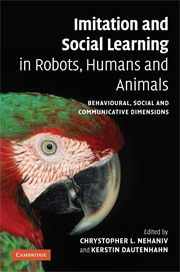 Imitation and Social Learning in Robots, Humans and Animals
Imitation and Social Learning in Robots, Humans and Animals Book contents
- Frontmatter
- Contents
- List of plates
- List of figures
- List of tables
- List of contributors
- Introduction: the constructive interdisciplinary viewpoint for understanding mechanisms and models of imitation and social learning
- Part I Correspondence problems and mechanisms
- Part II Mirroring and ‘mind-reading’
- Part III What to imitate?
- Part IV Development and embodiment
- 10 Copying strategies by people with autistic spectrum disorder: why only imitation leads to social cognitive development
- 11 A Bayesian model of imitation in infants and robots
- 12 Solving the correspondence problem in robotic imitation across embodiments: synchrony, perception and culture in artifacts
- Part V Synchrony and turn-taking as communicative mechanisms
- Part VI Why imitate? – Motivations
- Part VII Social feedback
- Part VIII The ecological context
- Index
- Plate section
- References
10 - Copying strategies by people with autistic spectrum disorder: why only imitation leads to social cognitive development
Published online by Cambridge University Press: 10 December 2009
- Frontmatter
- Contents
- List of plates
- List of figures
- List of tables
- List of contributors
- Introduction: the constructive interdisciplinary viewpoint for understanding mechanisms and models of imitation and social learning
- Part I Correspondence problems and mechanisms
- Part II Mirroring and ‘mind-reading’
- Part III What to imitate?
- Part IV Development and embodiment
- 10 Copying strategies by people with autistic spectrum disorder: why only imitation leads to social cognitive development
- 11 A Bayesian model of imitation in infants and robots
- 12 Solving the correspondence problem in robotic imitation across embodiments: synchrony, perception and culture in artifacts
- Part V Synchrony and turn-taking as communicative mechanisms
- Part VI Why imitate? – Motivations
- Part VII Social feedback
- Part VIII The ecological context
- Index
- Plate section
- References
Summary
Introduction
In neuroscience, if we wish to identify the brain areas that serve particular functions, a common approach is to study behaviour when part of the brain has been rendered inoperative as a result of injury or illness. By identifying the functional loss of a particular brain area, we can learn something about the role of that brain area in normal conditions. One problem with this approach is that it treats the brain as if its functional specialization was static rather than a dynamic and developing process. A brain area may feasibly serve a role in the development of a function, but lose that later in life. Therefore, we need to understand the processes that are necessary for the development of function and ask about the brain mechanisms that serve them. Then, if we can examine a condition in which those processes are impaired, and we can find the brain bases for that impairment, this might be a better way to appreciate the role of that brain area in serving the function in question. The way that we understand other people's thoughts may be a good case in point. It may be profitable to study the processes that contribute to the development of social understanding, if we are to understand its neural substrate in adulthood. Imitation seems likely to be one important developmental process, necessary for the acquisition of culture, language, knowledge and social cognitive abilities (Whiten et al., 2003; Meltzoff and Moore, 1999).
- Type
- Chapter
- Information
- Imitation and Social Learning in Robots, Humans and AnimalsBehavioural, Social and Communicative Dimensions, pp. 199 - 216Publisher: Cambridge University PressPrint publication year: 2007


